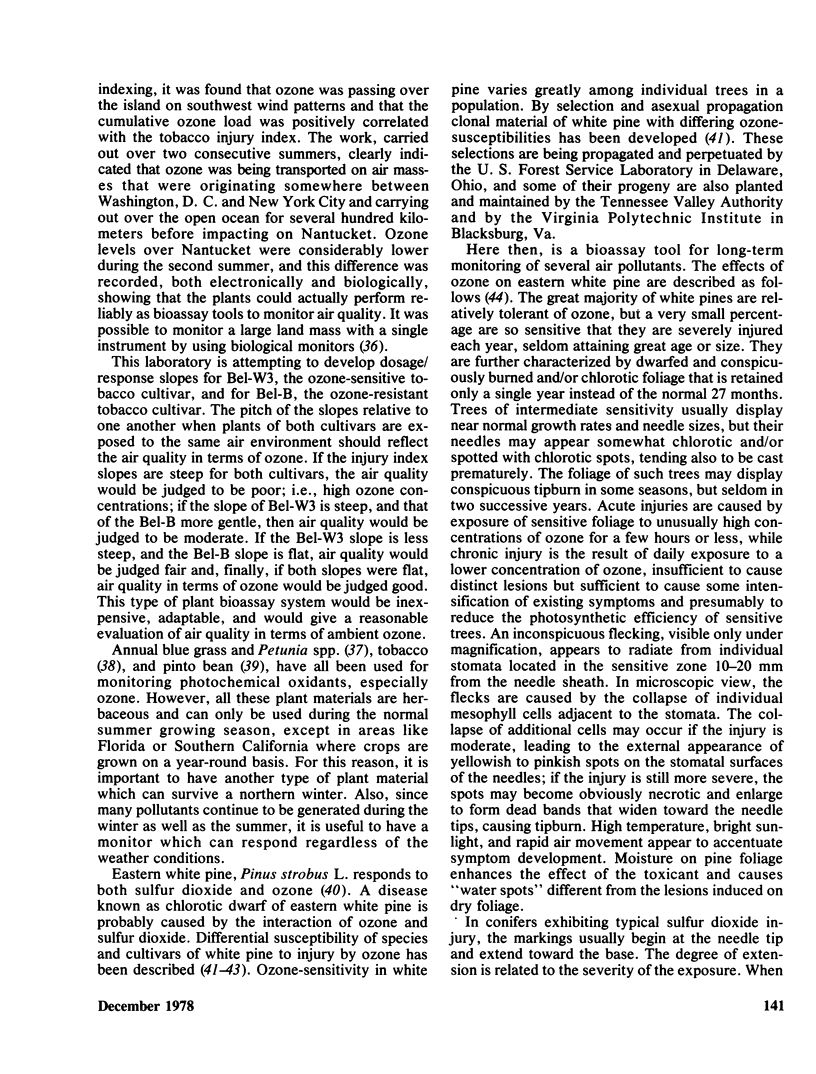Abstract
Plant species act as natural bioindicators of atmospheric pollutants. Plants can be used as bioassay systems for monitoring atmospheric pollutants. Plant injury symptoms, altered growth and reproductive pattern, changes in yield and/or productivity, and changes in species distribution can be used singly or in combination as monitoring devices. The results must be accepted as semiquantitative, but within that constraint, air quality can be sufficiently well defined to enable the setting of air quality standards. Genetic variability of higher plant species has yielded cultivars which display a range of tolerance to gaseous and particulate atmospheric pollutants. Asexual propagation of these cultivars provides pollutant-sensitive and pollutant-tolerant plant material which can be grown on selected sites for observation. Gymnosperm and Angiosperm species as well as species of lichens and mosses have been used to establish field monitoring networks in Europe, Canada, and the United States. White pine, shade tobacco, mosses, and lichens have proven particularly useful as bioassay tools. Pollen from pollutant-sensitive and pollutant-tolerant plant cultivars has also been used as a sensitive laboratory bioassay tool for studying air quality. Epiphytic mosses are particularly efficient as monitors of particulate pollutants, especially heavy metals, some of which may act as chemical mutagens. The cost, complexity, and lack of reliability of instrumented systems for air quality monitoring make imperative the need to develop successful plant bioassay systems for monitoring air quality.
Full text
PDF








Selected References
These references are in PubMed. This may not be the complete list of references from this article.
- Daines R. H. Sulfur dioxide and plant response. J Occup Med. 1968 Sep;10(9):516–534. doi: 10.1097/00043764-196809000-00015. [DOI] [PubMed] [Google Scholar]
- Darley E. F. Studies on the effect of cement-kiln dust on vegetation. J Air Pollut Control Assoc. 1966 Mar;16(3):145–150. doi: 10.1080/00022470.1966.10468456. [DOI] [PubMed] [Google Scholar]
- Dochinger L. S., Bender F. W., Fox F. L., Heck W. W. Chlorotic dwarf of eastern white pine caused by an ozone and sulphur dioxide interaction. Nature. 1970 Jan 31;225(5231):476–476. doi: 10.1038/225476a0. [DOI] [PubMed] [Google Scholar]
- Feder W. A. Reduction in tobacco pollen germination and tube elongation, induced by low levels of ozone. Science. 1968 Jun 7;160(3832):1122–1122. doi: 10.1126/science.160.3832.1122. [DOI] [PubMed] [Google Scholar]
- Goodman G. T., Roberts T. M. Plants and soils as indicators of metals in the air. Nature. 1971 Jun 4;231(5301):287–292. doi: 10.1038/231287a0. [DOI] [PubMed] [Google Scholar]
- Hawksworth D. L., Rose F. Qualitative scale for estimating sulphur dioxide air pollution in Engand and Wales using epiphytic lichens. Nature. 1970 Jul 11;227(5254):145–148. doi: 10.1038/227145a0. [DOI] [PubMed] [Google Scholar]
- Heck W. W., Dunning J. A., Hindawi I. J. Ozone: nonlinear relation of dose and injury in plants. Science. 1966 Feb 4;151(3710):577–578. doi: 10.1126/science.151.3710.577. [DOI] [PubMed] [Google Scholar]
- Heck W. W., Heagle A. S. Measurement of photochemical air pollution with a sensitive monitoring plant. J Air Pollut Control Assoc. 1970 Feb;20(2):97–99. doi: 10.1080/00022470.1970.10469381. [DOI] [PubMed] [Google Scholar]
- Jacobson J. S., Weinstein L. H., McCune D. C., Hitchcock A. E. The accumulation of fluorine by plants. J Air Pollut Control Assoc. 1966 Aug;16(8):412–417. doi: 10.1080/00022470.1966.10468494. [DOI] [PubMed] [Google Scholar]
- LEBLANC F. [Influence of the polluted atmosphere of great urban centers on corticole epiphytes]. Rev Can Biol. 1961 Dec;20:823–827. [PubMed] [Google Scholar]
- MIDDLETON J. T., PAULUS A. O. The identification and distribution of air pollutants through plant response. AMA Arch Ind Health. 1956 Dec;14(6):526–532. [PubMed] [Google Scholar]
- THOMAS M. D. Effects of air pollution on plants. Monogr Ser World Health Organ. 1961;46:233–278. [PubMed] [Google Scholar]


